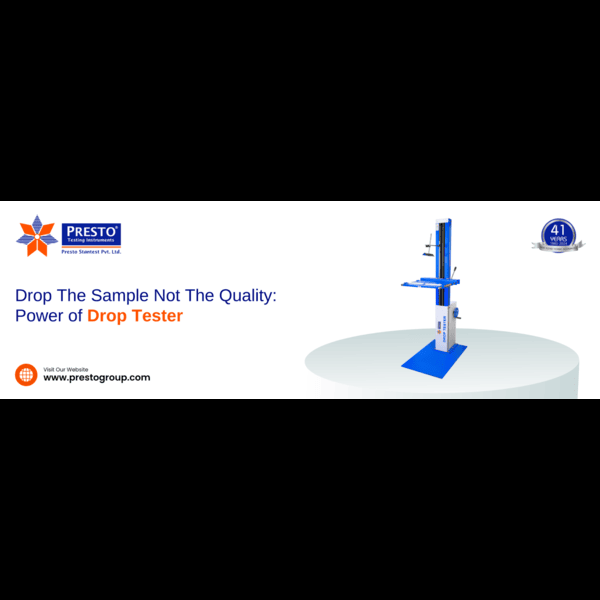In today’s competitive market, product durability is essential to brand reputation and customer satisfaction. A drop tester is a critical instrument for evaluating a product’s ability to withstand impact during shipping, handling, and use. From electronics to packaging materials, drop testers simulate real-world conditions that products may encounter, helping manufacturers identify weaknesses before products reach the market. In this blog, we’ll delve into how a drop tester works, the factors that influence its price, and how to select the right drop tester manufacturer and supplier for your needs.
What is a Drop Tester?
A drop tester is a testing device used to determine a product’s resilience to sudden impacts, replicating drops and falls that might occur during transportation or everyday use. By simulating falls from various heights and angles, the tester evaluates the ability of packaging materials or the product itself to absorb shock and resist damage. Manufacturers rely on drop testing to improve packaging design, adjust materials, and ensure product safety, ultimately enhancing customer satisfaction.
Types of Drop Testers
Drop testers come in various models, each suited to different applications. Some commonly used types include:
-
Free-Fall Drop Testers: These testers allow the product to fall freely from a specified height to measure its durability on impact.
-
Rotational Drop Testers: Commonly used for irregularly shaped or heavier items, these testers rotate the product before release to simulate more dynamic impacts.
-
Inclined Impact Testers: Used to assess packaging and large items, inclined impact testers propel the product at an angle to determine how it withstands oblique impacts.
Each type of drop tester offers unique benefits, enabling manufacturers to test a wide range of products and packaging styles.
Key Features of a Drop Tester
When choosing a drop tester, manufacturers should consider essential features, including:
-
Adjustable Drop Height: Allows users to select the precise height from which the product will be dropped.
-
Variable Angle Testing: Enables drops from different angles to simulate real-world conditions.
-
Durability and Stability: Ensures the tester itself withstands repeated impacts and provides consistent results.
-
Advanced Sensors and Controls: Modern drop testers may come equipped with sensors to measure impact force, speed, and other parameters for a thorough analysis.
These features contribute to the effectiveness of a drop tester and the accuracy of its results, helping manufacturers develop more durable products.
Understanding Drop Tester Price
The price of a drop tester can vary significantly depending on several factors, including:
-
Type and Model: Basic free-fall testers are often more affordable than rotational or inclined impact testers due to their simpler design.
-
Brand and Manufacturer: Trusted brands and established manufacturers may charge a premium for their equipment due to proven reliability and service quality.
-
Advanced Features: Testers with digital controls, advanced sensors, and extensive testing parameters typically cost more due to the added functionality.
-
Capacity and Load: Testers designed for heavy or oversized items are often more robust and, as a result, more expensive.
When comparing drop tester price, it’s crucial to consider the tester’s capabilities and the specific needs of your product testing to ensure the investment aligns with your requirements.
Choosing a Drop Tester Manufacturer
Finding the right drop tester manufacturer is crucial to obtaining reliable, high-quality equipment that will perform consistently over time. Here are some factors to consider:
-
Reputation and Reviews: Established manufacturers with a history of positive reviews often provide better service and more reliable equipment.
-
Product Range: A manufacturer offering multiple models and types of drop testers can better meet your specific testing requirements.
-
Customization Options: Some manufacturers offer customization based on client needs, such as adjustable drop heights, specific materials, or advanced data logging.
-
Service and Support: Look for a manufacturer with a strong support team and available service options to help maintain the tester in good condition.
Top drop tester manufacturers understand the diverse needs of industries and offer equipment that complies with international testing standards.
Choosing a Drop Tester Supplier
The right supplier can also play an essential role in ensuring you get the best drop tester for your needs. Here are some tips for selecting a reliable supplier:
-
Inventory and Availability: Suppliers with a wide inventory are more likely to have the model you need readily available.
-
Customer Service: A responsive supplier with strong customer service can help you navigate choices and provide valuable recommendations.
-
Technical Support: Suppliers who offer installation and training on equipment usage can be invaluable, especially if your team is unfamiliar with drop testing.
-
Warranty and Maintenance Options: Look for suppliers that provide warranties, maintenance packages, and post-purchase support to maximize the tester’s longevity.
Benefits of Using a Drop Tester
A drop tester offers multiple benefits for businesses looking to improve product quality and durability, including:
-
Enhanced Product Safety: By identifying vulnerabilities, drop testing helps improve the safety of products.
-
Reduced Returns and Complaints: Durable products lead to fewer returns and better customer satisfaction.
-
Cost Savings: Drop testing helps optimize packaging design and minimize damage-related costs.
-
Compliance with Standards: Drop testing ensures compliance with industry standards, which can be crucial for businesses operating internationally.
Conclusion: In an increasingly competitive market, product durability and quality are essential for brand reputation and customer loyalty. Investing in a high-quality drop tester from a reliable manufacturer and supplier can greatly enhance product resilience, ensuring that items can withstand the challenges of transportation and handling. By carefully considering drop tester prices, choosing the right type of drop tester, and working with trusted manufacturers and suppliers, companies can gain valuable insights into their products’ performance, optimize design, and ultimately deliver better products to their customers.



